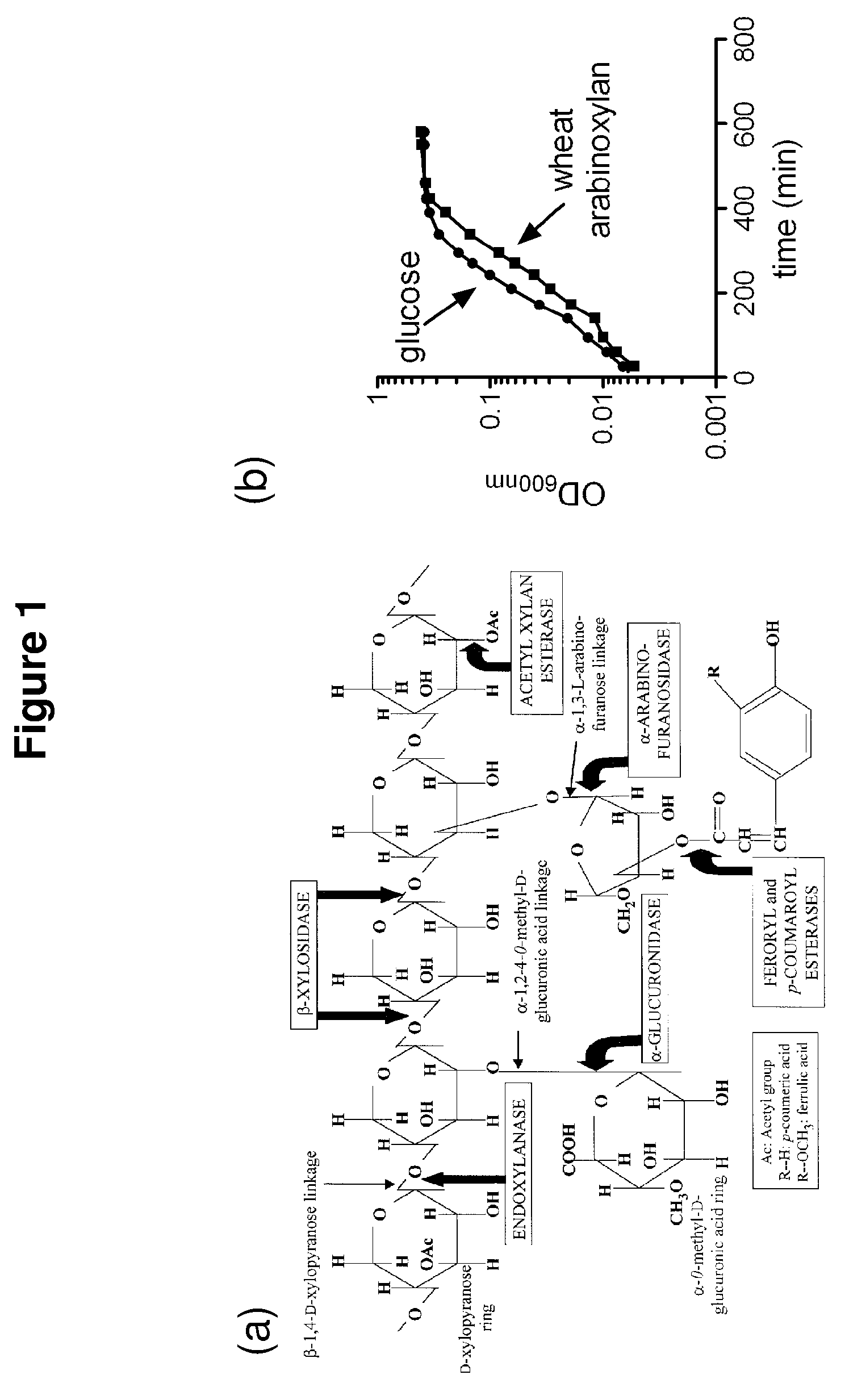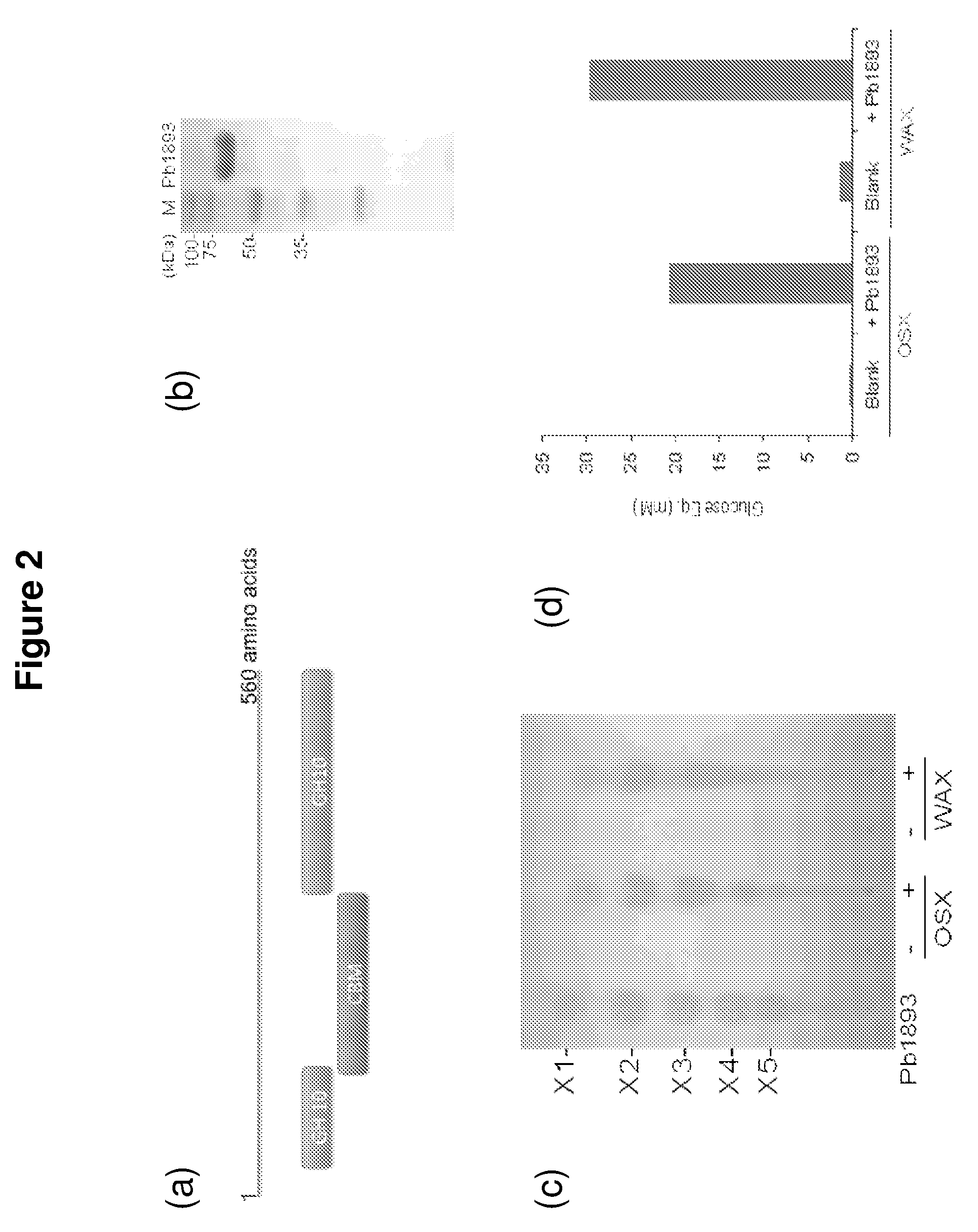Hemicellulose-degrading enzymes
a technology of hemicellulose and enzymes, which is applied in the field of hemicellulose degradation, can solve the problems of significant bottleneck in the conversion of lignocellulosic materials to biofuels, the inability of microorganisms to utilize complex polysaccharides such as cellulose and hemicellulose, and the inability to target the hemicellulose component of plant materials
- Summary
- Abstract
- Description
- Claims
- Application Information
AI Technical Summary
Benefits of technology
Problems solved by technology
Method used
Image
Examples
example 1
Endoxylanase Pb1893 (SEQ ID NOs: 1 & 2)
[0086]An endoxylanase, Pb1893, was identified in Prevotella bryantii. The enzyme is the gene product of Pb1893, where Pb stands for P. bryantii. The endoxylanase cleaves the xylose backbone of hemicellulose at random to generate shorter chains of xylose in β-1,4-linkages. These xylo-oligosaccharides can range from containing two or more sugar subunits. The Pb1893 protein is 561 amino acids long and has a molecular weight of 62.3 kDa (His-tag+truncated Pb1893 protein). The protein has a unique architecture due to a putative carbohydrate binding module (CBM) inserted within the Glycoside Hydrolase (GH) family 10 catalytic domain (FIG. 2a).
[0087]Cloning of Pb1893
[0088]The gene for Pb1893 was amplified from Prevotella bryantii B14 genomic DNA by PCR using PrimeSTAR HS DNA polymerase (TaKaRa). The Pb1893 gene was amplified using the following primer set:
[0089]
Pb1893ForNdeI(SEQ ID NO: 39)5′-CATATGGACCAGGATATTCCTGGTTTCACAACGGATGAGC-3′Pb1893RevXhoI(SEQ...
example 2
Arabinofuranosidase / Beta-Xylosidase Pb886 (Alternatively Named Pb2351) (SEQ ID NOs: 3 & 4)
[0124]An arabinofuranosidase, Pb886, was identified in Prevotella bryantii. This enzyme was also found to have β-xylosidase activity and thus is a bifunctional enzyme. As shown below, the first enzymatic activity (arabinofuranosidase) was higher than the second activity. Arabinofuranosidases cleave the arabinose side chains that decorate the β-1,4 xylose main chain. Since it was also shown to have beta-xylosidase activity, Pb886 must also attack the short chain xylo-oligosaccharides generated by endoxylanases (e.g., Pb1893) to generate xylose monomers. The protein is 560 amino acids in length and has a molecular weight of 62.9 kDa (His-tag+truncated Pb886 protein). It is a GH 43 arabinoxylan arabinofuranohydrolase.
[0125]Cloning of Pb886
[0126]The gene for Pb886 was amplified from Prevotella bryantii B14 genomic DNA by PCR using PrimeSTAR HS DNA polymerase (TaKaRa). The Pb886 gene was amplified u...
example 3
Beta-Xylosidase / Beta-Glucosidase Pb911 (SEQ ID NOs: 5 & 6)
[0148]A β-xylosidase, Pb911, was identified in P. bryantii. During the degradation of hemicellulose, β-xylosidases convert xylo-oligosaccharides produced by an endoxylanase to their monomeric sugars (xylose). P. bryantii has four genes encoding β-xylosidase-like enzymes. All four genes were cloned and expressed as soluble proteins. As shown below, one of these enzymes, Pb911, was initially screened on pNP substrates. The results suggested that Pb911 releases mostly xylose from a β-1,4-linked pNP and to a lesser extent arabinose from arabinose linked to pNP. The protein is 776 amino acids in length and has a molecular weight of 86.3 kDa (His-tag+truncated Pb911 protein). This protein is a GH 3 protein.
[0149]Cloning of Pb911
[0150]The gene for Pb911 was amplified and cloned into the Novagen pET-15b vector using the following primer sets Takara PrimeSTAR HS DNA Polymerase:
[0151]
Pb911ForNdeI(SEQ ID NO: 59)5′-GCGCCATATGCAAACTATACTT...
PUM
| Property | Measurement | Unit |
|---|---|---|
| temperature | aaaaa | aaaaa |
| temperature | aaaaa | aaaaa |
| pH | aaaaa | aaaaa |
Abstract
Description
Claims
Application Information
 Login to View More
Login to View More - R&D
- Intellectual Property
- Life Sciences
- Materials
- Tech Scout
- Unparalleled Data Quality
- Higher Quality Content
- 60% Fewer Hallucinations
Browse by: Latest US Patents, China's latest patents, Technical Efficacy Thesaurus, Application Domain, Technology Topic, Popular Technical Reports.
© 2025 PatSnap. All rights reserved.Legal|Privacy policy|Modern Slavery Act Transparency Statement|Sitemap|About US| Contact US: help@patsnap.com



